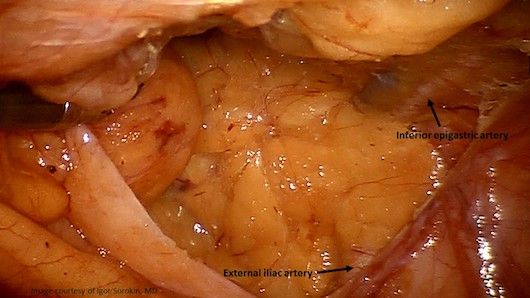Article
[Quiz]: Defect observed during RARP
Author(s):
A 65-year-old male with prostate cancer is undergoing robot-assisted laparoscopic radical prostatectomy (RARP). During the case, you notice a large defect medial to the inferior epigastric artery on the right side after taking down the bladder (figure 1, below). Similar defect is noted on the left side.

What is the name of this defect?
A. Femoral hernia
B. Direct inguinal hernia
C. Indirect inguinal hernia
D. Obturator hernia
Answer
B. Direct inguinal hernia
Discussion
A direct inguinal hernia enters through a weak point in the fascia of the abdominal wall, which is medial to the inferior epigastric artery. This space is referred as Hesselbach’s triangle, which is bounded by the rectus abdominus muscle, the inguinal ligament, and the inferior epigastric vessels. Incidental inguinal hernias are noted to occur in 13% of patients undergoing laparoscopic procedures. Furthermore, patients undergoing RARP have a 7%-21% risk of developing an inguinal hernia after the procedure.
Concomitant repair of an inguinal hernia after RARP has been demonstrated in several studies to be safe and effective. One can expect an approximately 15-minute increase in surgical time. It is recommended to perform the two procedures at the same time to reduce the cost and inconvenience of needing a second surgery and anesthesia.

Figure 2 above shows mesh being placed to cover the bilateral direct inguinal hernias after incidental discovery during RARP. The mesh is cut long enough to cover the defects and is most commonly fixed in place using either fibrin glue (Tisseel) or a tacking device. Both have shown similar efficacy, but there is a risk of postoperative pain with the tacking device from nerve injury. If utilizing a standard polypropylene mesh with the transperitoneal approach, it is necessary to perform reperitonealization to avoid bowel adhesions. Sometimes, this can be difficult after bladder mobilization. In this case, a dual expanded polytetrafluoroethylene (ePTFE)-coated mesh that is resistant to adhesion formation can be placed without the need to reperitonealize.
Dr. Sorokin, endourology fellow at the University of Texas Southwestern Medical Center, Dallas, is section editor for Urology Times Clinical Quiz.
Suggested reading
Concurrent transperitoneal repair for incidentally detected inguinal hernias during robotically assisted radical prostatectomy. Urology 2013; 82:1320-2.
Robotic radical prostatectomy with concomitant repair of inguinal hernia: is it safe? J Robot Surg. 2017 Aug 22 [epub] doi: 10.1007/s11701-017-0737-6.
Randomized clinical trial of fibrin glue versus tacked fixation in laparoscopic groin hernia repair. Surg Endosc. 2013; 27:2727-33.
To get weekly news from the leading news source for urologists, subscribe to the Urology Times eNews.

















